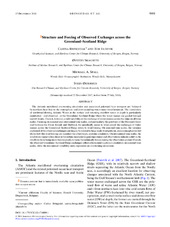| dc.contributor.author | Bringedal, Carina | |
| dc.contributor.author | Eldevik, Tor | |
| dc.contributor.author | Skagseth, Øystein | |
| dc.contributor.author | Spall, Michael A. | |
| dc.contributor.author | Østerhus, Svein | |
| dc.date.accessioned | 2019-05-22T12:57:45Z | |
| dc.date.available | 2019-05-22T12:57:45Z | |
| dc.date.issued | 2018 | |
| dc.Published | Bringedal C, Eldevik T, Skagseth Ø, Spall MA, Østerhus S. Structure and Forcing of Observed Exchanges across the Greenland–Scotland Ridge. Journal of Climate. 2018;31:9881-9901 | eng |
| dc.identifier.issn | 1520-0442 | en_US |
| dc.identifier.issn | 0894-8755 | en_US |
| dc.identifier.uri | https://hdl.handle.net/1956/19696 | |
| dc.description.abstract | The Atlantic meridional overturning circulation and associated poleward heat transport are balanced by northern heat loss to the atmosphere and corresponding water-mass transformation. The circulation of northward-flowing Atlantic Water at the surface and returning overflow water at depth is particularly manifested—and observed—at the Greenland–Scotland Ridge where the water masses are guided through narrow straits. There is, however, a rich variability in the exchange of water masses across the ridge on all time scales. Focusing on seasonal and interannual time scales, and particularly the gateways of the Denmark Strait and between the Faroe Islands and Shetland, we specifically assess to what extent the exchanges of water masses across the Greenland–Scotland Ridge relate to wind forcing. On seasonal time scales, the variance explained of the observed exchanges can largely be related to large-scale wind patterns, and a conceptual model shows how this wind forcing can manifest via a barotropic, cyclonic circulation. On interannual time scales, the wind stress impact is less direct as baroclinic mechanisms gain importance and observations indicate a shift in the overflows from being more barotropically to more baroclinically forced during the observation period. Overall, the observed Greenland–Scotland Ridge exchanges reflect a horizontal (cyclonic) circulation on seasonal time scales, while the interannual variability more represents an overturning circulation. | en_US |
| dc.language.iso | eng | eng |
| dc.publisher | American Meteorological Society | en_US |
| dc.subject | Ocean circulation | eng |
| dc.subject | Thermocline circulation | eng |
| dc.subject | Atmosphere-ocean interaction | eng |
| dc.subject | North Atlantic Oscillation | eng |
| dc.subject | Statistical techniques | eng |
| dc.subject | Time series | eng |
| dc.title | Structure and Forcing of Observed Exchanges across the Greenland–Scotland Ridge | en_US |
| dc.type | Peer reviewed | |
| dc.type | Journal article | |
| dc.date.updated | 2019-01-30T12:27:40Z | |
| dc.description.version | publishedVersion | en_US |
| dc.rights.holder | Copyright 2018 American Meteorological Society | en_US |
| dc.identifier.doi | https://doi.org/10.1175/jcli-d-17-0889.1 | |
| dc.identifier.cristin | 1645604 | |
| dc.source.journal | Journal of Climate | |
| dc.relation.project | EC/H2020: 727852 | |
| dc.relation.project | EC/FP7: 308299 | |
| dc.relation.project | Norges forskningsråd: 229763 | |
